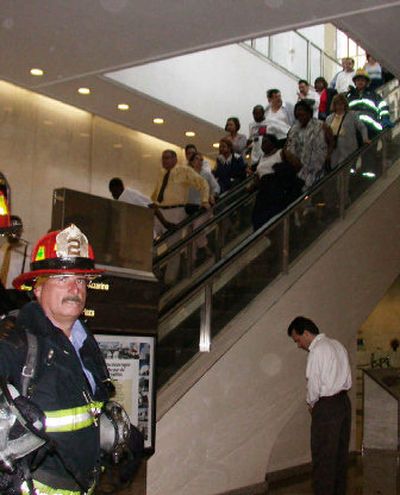9/11 histories add dimension to horror

NEW YORK – In thousands of pages of oral histories released Friday, firefighters describe in vivid, intimate detail how they rushed to save fleeing civilians from churning smoke and fire before the World Trade Center collapsed in a monstrous cloud of debris and choking dust.
The histories, recorded in the weeks after the Sept. 11 attacks, offer some of the most detailed descriptions of the day’s horror as seen through the eyes of firefighters who lost 343 of their brethren.
Firefighter Maureen McArdle-Schulman recalled hearing someone yell before the collapses that something was falling from the towers.
“It turned out it was people coming out, and they started coming out one after the other,” she said. “We didn’t know what it was at first, but then the first body hit and then we knew what it was. … I was getting sick. I felt like I was intruding on a sacrament. They were choosing to die and I was watching them and shouldn’t have been. So me and another guy turned away and looked at a wall and we could still hear them hit.”
Emergency medical technician John Felidi recalled that when the south tower fell, “We heard a rumble. I heard the rumble and looked – in the back of me all I seen was a monstrous – I can’t even describe it. A cloud. Looked like debris, dust.”
The 12,000 pages of oral histories were made public along with hours of Fire Department radio transmissions, their release brought on by a lawsuit filed three years ago by the New York Times and long contested by the city.
Some of the material had been released before, and the records released Friday were unlikely to fundamentally change the understanding of the Sept. 11 attacks.
Still, the histories offer a poignant catalog of firefighters’ still-fresh memories of the towers’ horrifying collapse. And the radio transmissions added new texture to the historical record of the day, beginning at 8:46 a.m. with an urgent but calm description of a plane crashing into the World Trade Center. “The World Trade Center tower Number One is on fire!” one firefighter radioed.
As the depth of the crisis became clear, the voices on the radios thickened with panic. “Send every available ambulance, everything you got to the World Trade Center,” a firefighter calls from Engine 1. “Now!”
Sept. 11 family members pored over the records Friday, some tearing up at descriptions and sounds of the attack and response. At an office building in midtown Manhattan, a half-dozen family members and two fire officers bent over laptops to examine the material.
Fire Lt. Jerry Reilly, who escaped the Trade Center, said the transmissions were almost too painful to hear. “I never heard any of this before – the chaos,” he said, his eyes tearing up.
The records shed light onto lingering questions and long-standing complaints about the response. Firefighters described faulty communications equipment and some disobeyed orders.
A group of victims’ families who have become advocates for reforming building codes and emergency response had awaited the release of the records in hopes they would challenge the notion that many firefighters in the north tower heard, but chose to ignore, an evacuation message issued after the south tower collapsed.
Some city officials have suggested some firefighters ignored the mayday call in acts of personal heroism. But the group of families has sought to lay blame on the city for providing firefighters with faulty radios.